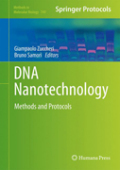
Currently, nanotechnology is exposing the properties of DNA in unprecedented detail leading to new insights on the biological behavior and function of DNA.With the structural perfection of a self-assembling DNA nano-object, such as a DNA origami, it is clear how complex DNA is as a molecule, leading researchers to wonder how many different constructs could be designed and realized. DNANanotechnology: Methods and Protocols shows the procedures to follow in orderto repeat methods that lead to such constructs or to the mastering of the characterization techniques used to study them. The chapters of this book are roughly divided into two parts: some cover the methods for preparing the nanostructures, from the rationale of the operations to the techniques for their handling, while other chapters deal more directly with advanced instrumental techniques that can manipulate and characterize molecules and nanostructures. Written in the highly successful Methods in Molecular Biology™ series format, chapters contain introductions to their respective topics, lists of the necessary materials and reagents, step-by-step, readily reproducible laboratory protocols,and notes on troubleshooting and avoiding known pitfalls. Authoritative and accessible, DNA Nanotechnology: Methods and Protocols serves as an ideal guide to scientists of all backgrounds and aims to ignite interest and spur activityin this young and rapidly growing research field.Includes cutting-edge methods and protocolsProvides step-by-step detail essential for reproducible resultsContains key notes and implementation advice from the experts Includes cutting-edge methods and protocolsProvides step-by-step detail essential for reproducible resultsContains key notes and implementation advice from the experts INDICE: Synthesis and Characterization of Self-assembled DNA Nanostructures. Protocols for Self-assembly and Imaging of DNA Nanostructures. Self-Assembly of Metal-DNA Triangles and DNA Nanotubes with Synthetic Junctions. DNA-Templated Pd Conductive Metallic Nanowires. A Method to Map Spatiotemporal pH Changes Inside Living Cells using a pH Triggered DNA Nanoswitch. Control of Helical Handedness in DNA and PNA Nanostructures. G-quartet, G-quadruplex, and G-wire Regulated by Chemical Stimuli. Preparation and Atomic Force Microscopy of Quadruplex DNA. Synthesis of Long DNA-based Nanowires. G-wire Synthesis and Modification with Gold-nanoparticle. Preparation of DNA Nanostructures with Repetitive Binding Motifs by Rolling Circle Amplification. Controlled Confinement ofDNA at the Nanoscale: Nanofabrication and Surface Bio-functionalization. Templated Assembly of DNA Origami Gold Nanoparticle Arrays on Lithographically Patterned Surfaces. DNA-modified Single Crystal and Nanoporous Silicon. The Atomic Force Microscopy as a Lithographic Tool: Nanografting of DNA Nanostructures for Biosensing Applications. Trapping and Immobilization of DNA Molecules Between Nanoelectrodes. DNA Contour Length Measurements as a Tool for the Structural Analysis of DNA and Nucleoprotein Complexes. DNA Molecular Handles for Single Molecule Protein Folding Studies by Optical Tweezers. Optimal Practices forSurface-tethered Single Molecule Total Internal Reflection Fluorescence Resonance Energy Transfer Analysis. Engineering Mononucleosomes for Single-Pair FRET Experiments. Measuring DNA-Protein Binding Affinity on a Single Molecule Using Optical Tweezers. Modeling Nanopores for Sequencing DNA
- ISBN: 978-1-61779-141-3
- Editorial: Humana Press
- Encuadernacion: Cartoné
- Páginas: 320
- Fecha Publicación: 25/06/2011
- Nº Volúmenes: 1
- Idioma: Inglés
